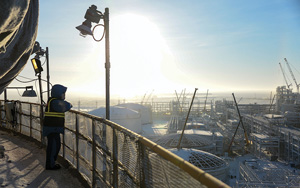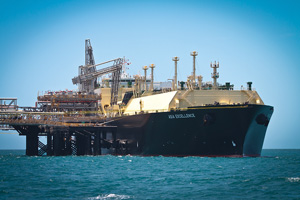Industry Perspectives
Russia aims to ally with Qatar in LNG competition with Australia and other LNG-exporting majors over the coming years. Amid ever-tightening competition in the global gas market, including the LNG segment, Russia is looking for new allies so that it may remain competitive for years to come. An alliance with Russia could also be of interest to Qatar, which is likely to lose some large-scale export contracts held by Asia-Pacific buyers after 2020.
Russia has strong positions in pipeline gas, mainly due to its cooperation with Iran—the country’s major ally in the Middle East. Russia is seeking a similar ally in the case of LNG. Again, Qatar is a possible option. The Russian government hopes that strengthening cooperation with Qatar will create conditions for expanding the geography of its LNG supplies.
Russia already considers Qatar a strategic ally in its expansion in the global energy market. In January 2017, the Russian government sold a 19.5% stake in Rosneft, Russia’s leading oil producer, to the Qatar Investment Authority for a record sum of $11.92 B. The acquisition of Rosneft’s stake provided Qatar with the opportunity to influence the activities of one of the world’s largest oil producers, and gave it access to Russia’s oil and gas reserves. The sale of Rosneft’s stake to the Qatar business may also mean that the Russian government expects more active assistance from Qatar in its expansion into the global LNG market.
Russia’s high hopes for LNG. Contrary to the predictions of some analysts, sanctions have not prevented the implementation of planned LNG projects in Russia. The country aims to achieve its earlier announced target to increase its total LNG production to 81 metric MMtpy by 2035. However, reaching this goal will largely depend on the rates of implementation of the majority of investment projects planned for the coming years, along with the development of Russia’s place in the global LNG market.
Russian privately-owned LNG producer Novatek recently stated that it will start exports of LNG from its plant in the Yamal Peninsula in the Russian Arctic region by the end of 2018. The plant will be the third large-scale LNG project in Russia and the second LNG plant for Novatek, which could become the world’s largest producer of LNG. The commissioning of Novatek’s Yamal LNG project, which is scheduled for the end of November (Fig. 1), will boost Russia’s overall LNG production by 16.5 metric MMtpy and could make it the third-largest producer after Australia by early 2019. At present, Russia holds approximately 4% of the global LNG market.
 |
|
Fig. 1. The commissioning of Novatek’s Yamal LNG project is scheduled for the end of November 2018. |
The capacity of the Yamal project will be increased by up to 17.5 metric MMtpy by the construction of its fourth train over the next several years. Russia’s LNG production capacity will be further expanded by the commissioning of the Arctic LNG 2 project in the same time frame. The development of these two projects could boost Russia’s LNG production at Yamal by 70 metric MMtpy, which is comparable with Qatar’s yearly production volumes.
In addition to Novatek, leading Russian gas producer Gazprom plans to build new LNG facilities. The terminals will be located in St. Petersburg and the Vladivostok region (Sakhalin-2 export project) (Fig. 2), as well as a regasification terminal in the Kaliningrad region.
 |
|
Fig. 2. Gazprom’s Sakhalin-2 project on Russia’s Sakhalin Island, north of Japan, includes development of the Piltun-Astokhskoye oil field and the Lunskoye natural gas field. |
In 2017, Russia became the world’s seventh-largest LNG exporter, with deliveries amounting to 10.8 metric MMt. At present, Russia controls approximately 4% of the global LNG market and plans to increase its presence in the coming years. In early 2018, Russian President Vladimir Putin noted that Russia has a significant opportunity to become the world’s largest LNG exporter. To achieve this goal, the country will need to maintain its present gas production rate and boost its LNG export volumes. Russia will implement these plans with the help of its foreign partners, one of which is Qatar.
Strengthening cooperation. Russia’s deepening connection with Qatar could also be beneficial to the Middle Eastern country, as it may lose some of its major LNG contracts in the coming years.
Vladislav Vorotnikov, a former senior analyst at the Russian Ministry of Energy, commented on the Russia-Qatar relationship, “Russia hopes to gain advantage over the ongoing tensions between Qatar and other Persian Gulf states and enter into a strategic alliance with the Qatar government. This will provide an opportunity for Russia to coordinate activities in the global LNG market with one of its largest players. The same scheme is already used in Russia with Iran in the segment of pipeline gas.”
At present, Japanese importers of Qatar’s LNG continue to pressure the Qatar government, forcing it to make concessions while signing new contracts and prolonging existing ones. Representatives of Tokyo Gas Co. and JERA Co., Japan’s leading LNG importers, have not yet made final decisions on whether to sign new contracts with Qatar. The majority of the existing contracts will expire in 2021. Japan hopes for significant discounts for new supplies from Qatar, following the predicted decline of global LNG prices after 2020.
Japan insists that the signing of new long-term contracts with global LNG producers be tied to the opportunity to resell the surplus of supplied LNG. This fits with Japan’s ambitious plan to become a new center of international LNG trade in Asia. The Japanese government plans to allocate ¥1 T ($10 B) for this purpose. The majority of the funds will be used for the establishment and development of LNG-related infrastructure in Asia. During the next 5 yr, Japan will train 500 technical experts in the field of LNG to develop this infrastructure. These plans also involve the construction of warehouses for LNG storage and the establishment of an exchange for LNG trade.
Qatari and Australian LNG producers are skeptical of Japan’s plans, as they fear their incomes will be largely formed by the spot market, rather than by long-term contracts.
The majority of global LNG producers oppose the practice of tying the cost of LNG to oil prices, which is favored by Japan. The Russian Ministry of Energy believes the alliance with Russia could be of interest to Qatar, which is seeking ways to diversify its energy exports. Qatar’s significant dependence on LNG exports makes it vulnerable to potential economic blockades and trade wars. For this reason, the country is working to increase its presence in the EU’s LNG market, particularly in LNG receiving terminals in the UK.
The Russian government hopes that strengthening its cooperation with Qatar will provide it access to the Japanese market, where it will be able to sell its LNG at lower prices than those proposed by both Qatar and Australia. In exchange, Russia will be ready to provide Qatar with stakes in some of its largest oil projects, such as those being implemented by Rosneft. Russia may also provide assistance to Qatar in expanding its reach into the EU’s LNG market.
However, the question of a possible LNG oversupply remains, particularly in Japan, where the government is rebuilding and reopening nuclear reactors that were shut down in the wake of the 2011 Fukushima nuclear disaster. Australia is providing a considerable portion of the LNG demand of Japan and South Korea (Fig. 3).
 |
|
Fig. 3. A shipment of LNG to Japan from Chevron’s Gorgon project, located off the northwest coast of Western Australia. |
China is also reviewing its strategy of energy balance and may need less LNG in the coming years than was previously forecast. Most analysts see the LNG glut as short-term, however, with the potential for an emerging deficit after 2025 as new countries join the ranks of LNG importers. In 2017, six nations began importing LNG for the first time: Colombia, Egypt, Jamaica, Jordan, Pakistan and Poland.
According to forecasts by energy major Shell, China, Japan and India will remain the largest driving force behind growing demand for LNG. In 2017, China’s LNG imports increased to 27 metric MMt, making it the second-largest importer behind South Korea, while India boosted its LNG imports to 20 metric MMt. In 2018, India is anticipated to expand its LNG imports by 20%, while new importer Pakistan will need to import 50% more LNG to reduce its growing gas deficit. Mexico, Thailand and Turkey are also expected to increase their LNG imports this year. Meanwhile, Bangladesh became the first new importer of 2018, receiving a cargo from Qatar in late April.
The direction of the LNG market—and of export players’ partnerships—will depend largely on the development of pricing situations. The cost of LNG supplied to Asia has been traditionally tied to oil prices, while prices for LNG delivered to Europe and exported from North America have been tied to gas hubs. This scenario has led to the formation of different price levels, as well as to disparities between these levels. Nonetheless, the number of short-term spot contracts for LNG supplies is expected to increase as new players appear on the market. GP
Eugene Gerden is an international contributing writer specializing in the global oil refining and
gas industry. He has been published in a number of prominent industry publications.




Comments